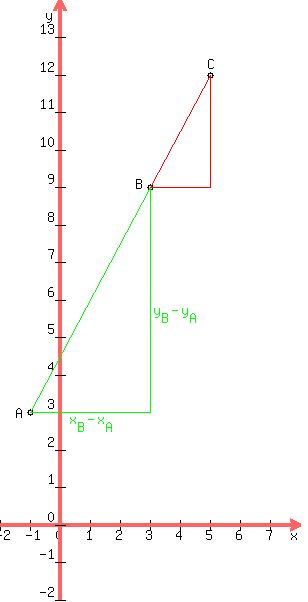|
Question 1032691: Please help me solve this;
Given are two points A(-1,3) and B(3,9).(a) Show that C(5,12)is a point of AB. (b) A Point P(x,y) moves in such a way that AP^2+CP^2=2BP^2. Find the equation of the locus of P. (c)Show that this locus is a straight line perpendicular to AB.
Answer by KMST(5328)   (Show Source): (Show Source):
You can put this solution on YOUR website! (a) is easy.
A picture is not needed, but I will add a picture so you can visualize it:

Given points  and and  , the slope of AB is , the slope of AB is

For  and and  , the slope of AB is , the slope of AB is
 . .
For  and and  , the slope of BC is , the slope of BC is
 . .
Since AB and BC have the same slope, they are either parallel or the same line.
As they have point B in common, AB and BC are the same line.
(b) ONE WAY TO GO ABOUT IT (ugly, but probably the expected way):
If point P is 
 , ,
 , and , and
 . .
So  , and , and

So,  means means




That is the equation of a straight line, which is the locus of P.
Transforming the equation into slope-intercept form, we get
 --> -->  --> -->  --> -->  . .
We could also just find the slope, using a formula.
Either way, the slope of the line is  . .
If the product of that slope and the slope of AB (found in part (a) is  , ,
then the lines are perpendicular, and it so happens that
 , so the locus of P is a line perpendicular to AB. , so the locus of P is a line perpendicular to AB.
ANOTHER WAY (possible, depending on what you have already covered in math classes):
When calculating the slopes of AB and BC,
you may have noticed that for points A, B and C
 and and  . .
That tells you that for the distances  . .
We could calculate those distances, but I only care about their ratios,
so for easier writing, I will rename the distances as  and and  . .
You may think of point P as not being on line AB.
However, as it is a moving point, at some point it could be on line AB,
but in that very special case, I would call it point D, and I will say it is a distance  to the other side of A. to the other side of A.
I will find  . .
The situation would be like this, with the distances:
 . (If D is not on the side of A I assumed it to be, . (If D is not on the side of A I assumed it to be,  will be a negative value). will be a negative value).
Since now P is at D, the equation with the squares is




 and since we know that and since we know that  (even though we did not calculate it), we divide both sides by (even though we did not calculate it), we divide both sides by  and get and get
 . .
Now, what about a point P that is not D?
 . .
With the Pythagorean theorem (applied to all 3 triangles including side DP), we can easily prove that if P is such that AB and DP are perpendicular, then  . .
The other way around (proving that if  , then AP and DP are perpendicular) I believe requires using the law of cosines, which may be beyond what you have studied. , then AP and DP are perpendicular) I believe requires using the law of cosines, which may be beyond what you have studied.
|
|
|
| |